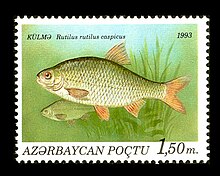Vobla
| Rutilus caspicus | |
|---|---|

| |
| Vobla on Azerbaijani postage stamp | |
| Scientific classification | |
| Kingdom: | |
| Phylum: | |
| Class: | |
| Order: | |
| Family: | |
| Genus: | |
| Species: | Rutilus caspicus
|
| Binomial name | |
| Rutilus caspicus (Yakovlev, 1870)
| |
| Synonyms | |
| |
The vobla (Rutilus caspicus), also termed the Caspian roach, is a species of cyprinid fish inhabiting the Caspian Sea and inflowing rivers. It is closely related to the common roach (R. rutilus) and often considered its subspecies, R. r. caspicus.
Salt-dried vobla is a common Russian meal or snack that goes well with beer. It is popular in many Russian households and beer restaurants.
Description
The vobla has a typical size of 30–35 cm (maximum published 45 cm) and a weight of 800 g (maximum published 2000 g). It can be distinguished from its congeners in the Caspian Sea by these characteristics:
- usually 42-44 scales along the lateral line
- dorsal fin usually with 9½ branched rays
- anal fin usually with 10½ branched rays
- rounded snout and subterminal mouth
- anal fins and pectoral pelvic are grey with dark margins
Distribution
The vobla is found in brackish coastal waters of the northern and northwestern Caspian Sea, and enters Volga, Ural, Emba, Terek, and Kura drainages for spawning.
Food use
Salt-dried vobla is generally eaten without sauces or side dishes. Many people like to eat their vobla with a glass of beer, which lessens the salty taste of the fish.
Vobla could be considered a raw fish, but, in fact, it is neither raw nor cooked, but rather salt-cured. It is soaked in brine for some days and then is thoroughly air-dried for another two, which in the end denatures the protein, as a form of chemical "cooking".
-
Salt-dried vobla
See also
External links
- Froese, Rainer; Pauly, Daniel, eds. (April 2012). "Rutilus caspicus". FishBase. 65244.
- Rutilus rutilus caspicus (Jakowlew, 1870) www.caspianenvironment.org
- Template:IUCN


